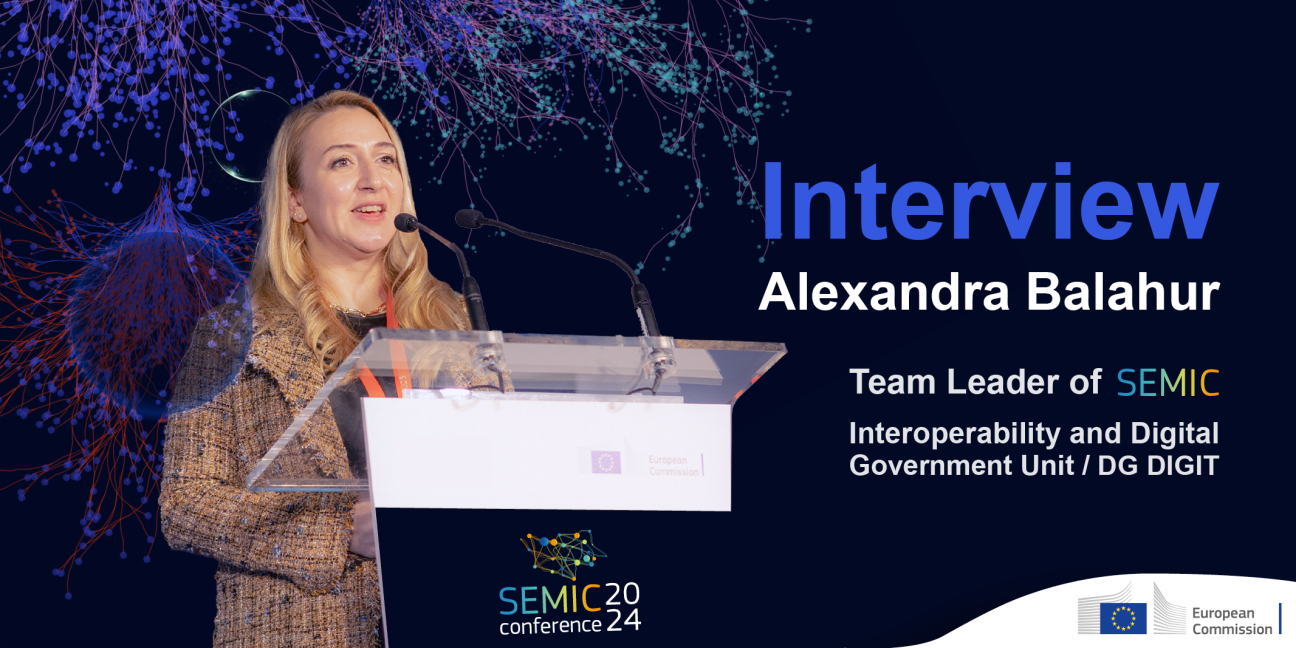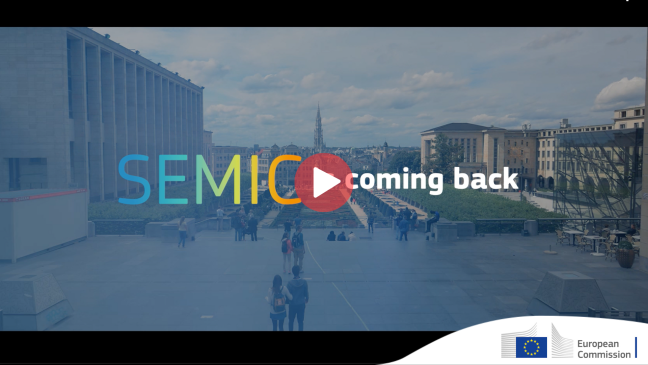Driving Digital Transformation: Alexandra Balahur Talks SEMIC and Semantic Interoperability
more news
Alexandra Balahur is the team leader of SEMIC, the semantic interoperability project and community in the Interoperability and Digital Government Unit of the Commission’s Directorate-General for Digital Services (DG DIGIT).
Her primary role involves coordinating efforts in semantic interoperability within her unit and bridging activities with other teams, such as Digital-Ready Policymaking, Open Source, and others. Additionally, she collaborates with other units engaged in data spaces and other Commission Directorates, such as DG GROW and the Publication Office (OP), linking semantic interoperability or artificial intelligence to the interoperability initiatives of DG DIGIT.
Alexandra is also the main organising force behind the annual semantic interoperability conference of the European Commission.
This year, SEMIC is set to take place in Brussels on 27 June. In collaboration with the Belgian Presidency of the Council of the European Union, our flagship event will explore the wider context of the Interoperable Europe Act and its future implementation through the development, sharing, and reuse of interoperability solutions, services, and products.
In this interview, Alexandra lifts the curtain on some of the key highlights of this year’s SEMIC. Scroll down to learn all about the biggest SEMIC yet! But before that, secure your spot, in person or online at www.semic2024.eu.
Q: With SEMIC 2024 just around the corner on 27 June in Brussels, could you share this year's spotlight topic and what attendees can expect?
A: This year’s central theme is “Interoperable Europe: From Vision to Reality.” With the adoption of the Interoperable Europe Act, the next step is to bring together all the components needed to translate its vision into reality for Member States and the Commission. The SEMIC conference will cover various components of this process, from our core focus on semantic interoperability to artificial intelligence (AI) and data spaces, which are crucial for interconnecting data and infrastructures. We will also dive into digital-ready policymaking and open-source solutions that support interoperability. Attendees can expect a blend of policy-oriented and technical discussions, providing insights into existing solutions and the opportunities and challenges presented by emerging technologies.
Q: SEMIC is usually held in autumn, but this year it's scheduled for June. Could you explain why?
A: Indeed, SEMIC traditionally aligns with the rotating Presidency of the Council of the European Union during the second half of the year. However, this year, the Belgian Presidency takes place in the first half of 2024 and since the Commission is also based in Belgium, it was natural to schedule the conference during this period.
Q: How has the format of SEMIC evolved compared to previous years?
A: Last year, we introduced pre-conference workshops, which we are organising again this year. These workshops allow for deeper technical discussions on topics related to semantic interoperability and new technologies that support interoperability. While the main conference caters to a broad audience, these workshops are designed for smaller, more focused groups who are keen on discussing detailed technical solutions and implementations.
Q: Who should attend SEMIC?
A: SEMIC welcomes a diverse audience including EU officials, national public administrations, policymakers, academia, and industry representatives. We will also feature EXPO stands for companies and institutions to showcase their interoperability-related work. The conference offers a unique platform for networking, sharing best practices, and learning about the latest developments in interoperability and digital government.
Q: Could you explain the differences between the benefits for pre-conference and main conference attendees?
A: Certainly. The main distinction lies in the scale and focus of the interactions. The pre-conference workshops are designed for smaller groups, typically hosting around 50 to 60 participants onsite. These sessions will also be available online, allowing a wider audience to join virtually. The content in these workshops is highly technical, focusing on detailed discussions of current research, technical solutions, and developments. They cater specifically to experts or those deeply engaged in the hands-on aspects of semantic interoperability and related fields.
In contrast, the main conference accommodates a much larger audience, with expectations of about 500 attendees in person and more than 800 joining online. The format provides a platform for broader dialogue on policy-level topics and strategic visions. This includes high-profile interventions from policy makers and top officials who discuss broader implementation strategies and visions at the country level. The main conference is about painting a bigger picture and less about the granular details of technical implementations.
Q: Here is a question for those of our readers, who are not that well acquainted with semantics. Is it correct to say that semantic interoperability and the semantics explored by Large Language Models in artificial intelligence are connected and that these two areas can support one another to bring about the next generation of digital public services?
A: Absolutely, and that's a fascinating aspect. Aligning on the Semantics (meaning) of language and concepts lies at the core of both semantic data models, as well as building Large Language Models and generative AI. However, in large language models (LLM), semantics are represented implicitly through mathematical models that illustrate the relational distances between concepts. This means the relationships and meanings are not explicitly defined; they're inferred from their mathematical relationships in a model.
Conversely, semantic interoperability involves explicitly defining these relationships. Concepts are aligned with specific ontologies or thesauri, making the meanings and relationships clear and unambiguous. For example, when we define 'person' in semantic models, we align this concept with an ontology that precisely outlines what 'person' represents. This explicit approach helps eliminate ambiguity. In AI models, the same word can imply different concepts and different granularities based on its context within the semantic space. This distinction highlights the explicit nature of semantic interoperability in contrast to the implicit representations built in AI models.
Q: Great explanation! We hope it sparkles even more curiosity and interest in SEMIC. Finally, if you had to invite people to SEMIC 2024 with a personal message, what would it be?
A: I encourage everyone interested in the future of digital public services and digital government to join us at SEMIC 2024. It's an opportunity to explore existing and innovative digital public services, expand your network, and connect with like-minded professionals and policymakers. Understand policies and discover projects that are redefining the landscape of public sector interoperability. Registration is still open, but I hear seats are filling up quickly.
Make sure you reserve yours at www.semic2024.eu

